Annotated Bibliography: Virtual Reality in Hotel Marketing Plan
VerifiedAdded on 2023/06/10
|9
|1551
|280
Annotated Bibliography
AI Summary
This annotated bibliography explores the inclusion of Virtual Reality (VR) in marketing plans, particularly within the hospitality and tourism sectors. It analyzes seven key articles that discuss VR's applications in tourism, its impact on consumer perception through 3D visualization, the use of smartphone augmented reality, and the economic implications of VR in presenting nonmarket goods. The bibliography further examines VR's role in cultural heritage through 3D reconstruction and the potential of virtual social worlds like Second Life for marketing purposes. Each annotation summarizes the article's main points, data sources, and relevance to enhancing revenue and customer experience in the hotel industry. This resource provides valuable insights for marketing directors aiming to leverage VR technology to attract tourists and improve destination marketing strategies. Desklib provides access to this and other solved assignments for students.
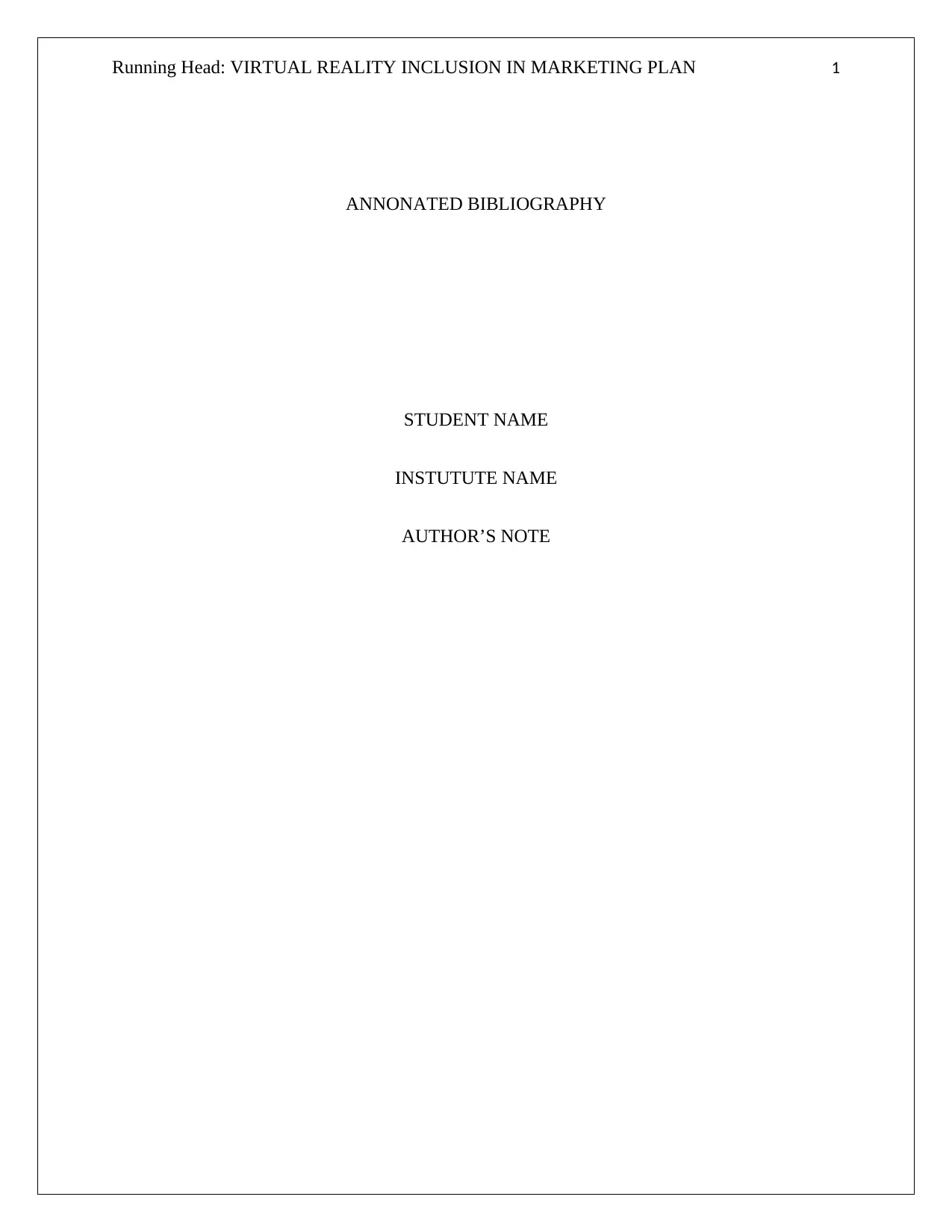
Running Head: VIRTUAL REALITY INCLUSION IN MARKETING PLAN 1
ANNONATED BIBLIOGRAPHY
STUDENT NAME
INSTUTUTE NAME
AUTHOR’S NOTE
ANNONATED BIBLIOGRAPHY
STUDENT NAME
INSTUTUTE NAME
AUTHOR’S NOTE
Paraphrase This Document
Need a fresh take? Get an instant paraphrase of this document with our AI Paraphraser
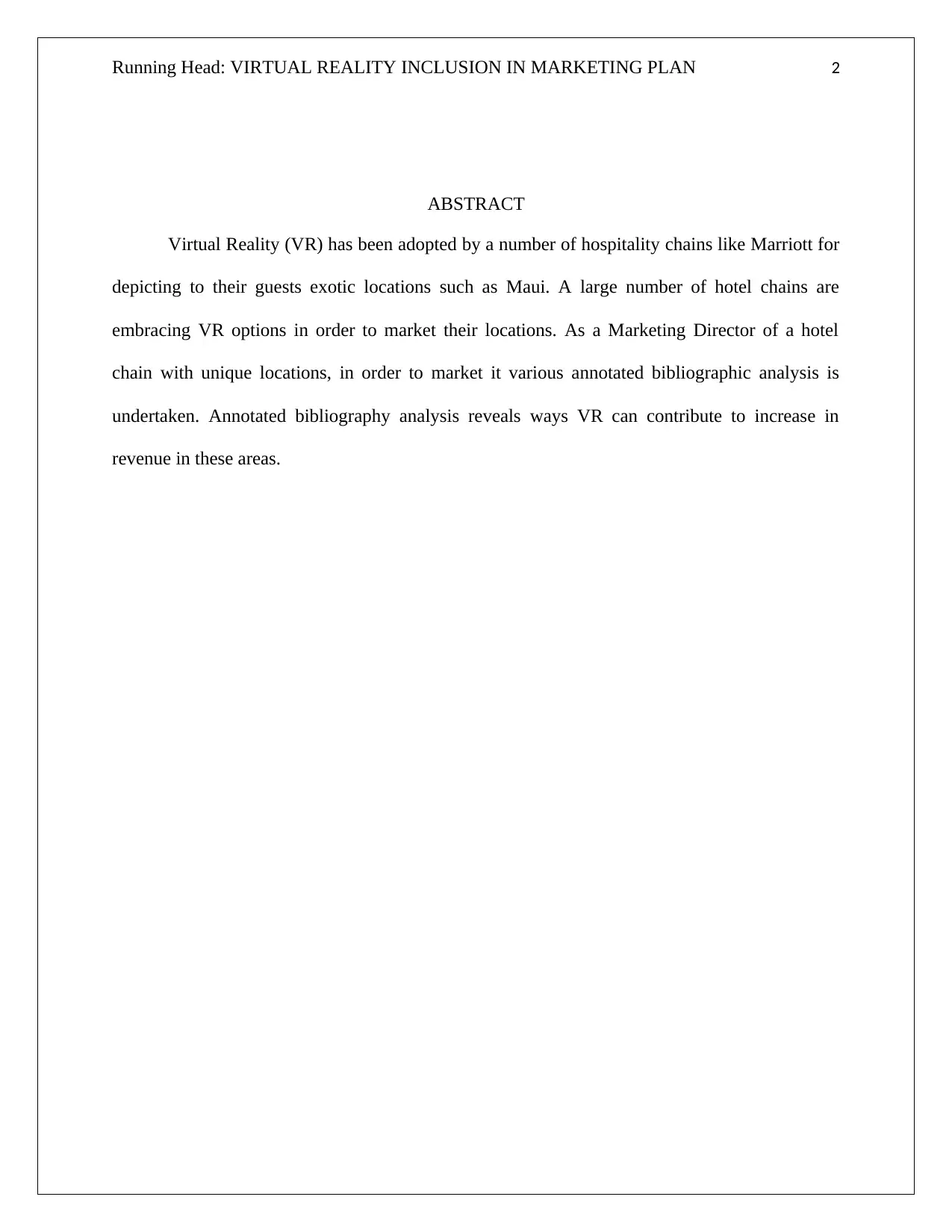
Running Head: VIRTUAL REALITY INCLUSION IN MARKETING PLAN 2
ABSTRACT
Virtual Reality (VR) has been adopted by a number of hospitality chains like Marriott for
depicting to their guests exotic locations such as Maui. A large number of hotel chains are
embracing VR options in order to market their locations. As a Marketing Director of a hotel
chain with unique locations, in order to market it various annotated bibliographic analysis is
undertaken. Annotated bibliography analysis reveals ways VR can contribute to increase in
revenue in these areas.
ABSTRACT
Virtual Reality (VR) has been adopted by a number of hospitality chains like Marriott for
depicting to their guests exotic locations such as Maui. A large number of hotel chains are
embracing VR options in order to market their locations. As a Marketing Director of a hotel
chain with unique locations, in order to market it various annotated bibliographic analysis is
undertaken. Annotated bibliography analysis reveals ways VR can contribute to increase in
revenue in these areas.
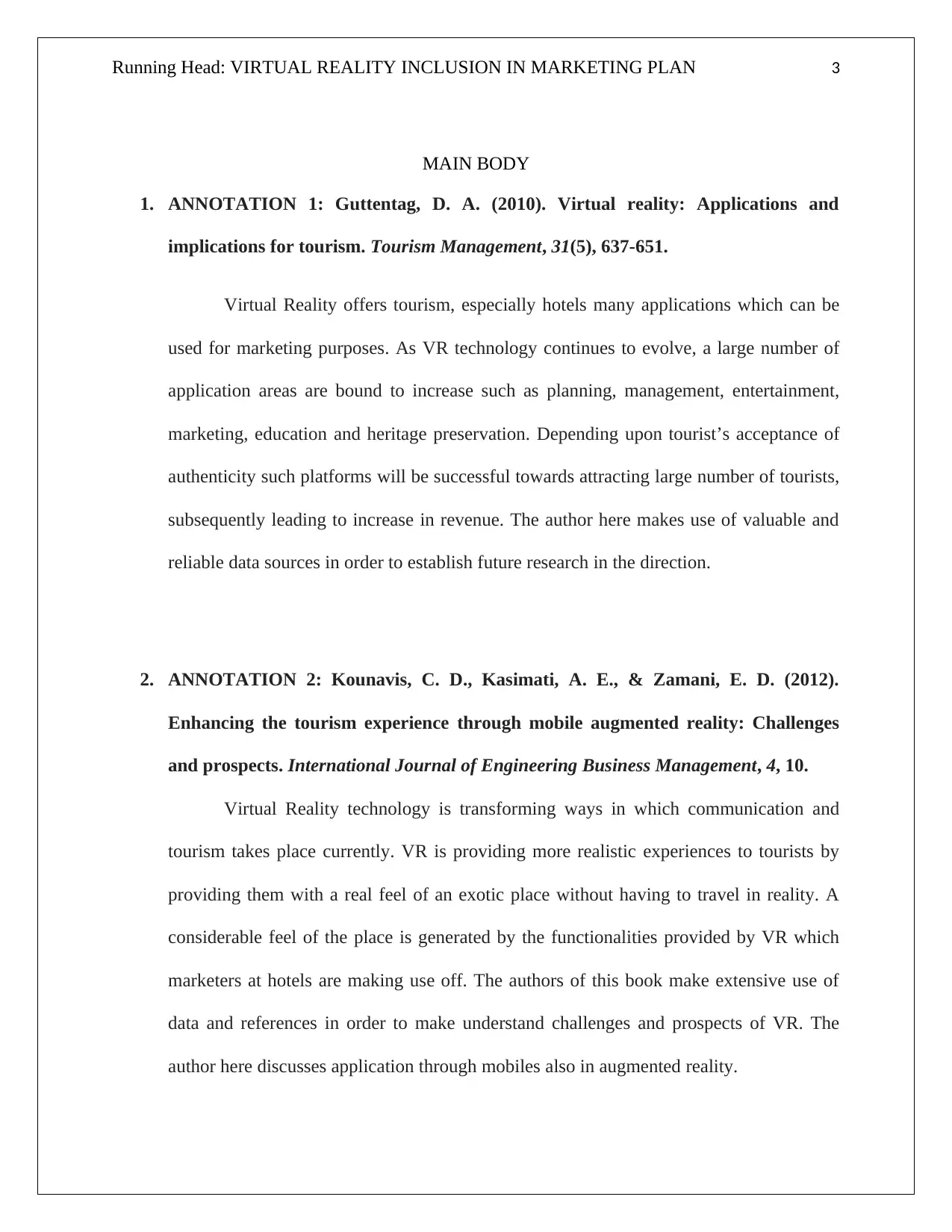
Running Head: VIRTUAL REALITY INCLUSION IN MARKETING PLAN 3
MAIN BODY
1. ANNOTATION 1: Guttentag, D. A. (2010). Virtual reality: Applications and
implications for tourism. Tourism Management, 31(5), 637-651.
Virtual Reality offers tourism, especially hotels many applications which can be
used for marketing purposes. As VR technology continues to evolve, a large number of
application areas are bound to increase such as planning, management, entertainment,
marketing, education and heritage preservation. Depending upon tourist’s acceptance of
authenticity such platforms will be successful towards attracting large number of tourists,
subsequently leading to increase in revenue. The author here makes use of valuable and
reliable data sources in order to establish future research in the direction.
2. ANNOTATION 2: Kounavis, C. D., Kasimati, A. E., & Zamani, E. D. (2012).
Enhancing the tourism experience through mobile augmented reality: Challenges
and prospects. International Journal of Engineering Business Management, 4, 10.
Virtual Reality technology is transforming ways in which communication and
tourism takes place currently. VR is providing more realistic experiences to tourists by
providing them with a real feel of an exotic place without having to travel in reality. A
considerable feel of the place is generated by the functionalities provided by VR which
marketers at hotels are making use off. The authors of this book make extensive use of
data and references in order to make understand challenges and prospects of VR. The
author here discusses application through mobiles also in augmented reality.
MAIN BODY
1. ANNOTATION 1: Guttentag, D. A. (2010). Virtual reality: Applications and
implications for tourism. Tourism Management, 31(5), 637-651.
Virtual Reality offers tourism, especially hotels many applications which can be
used for marketing purposes. As VR technology continues to evolve, a large number of
application areas are bound to increase such as planning, management, entertainment,
marketing, education and heritage preservation. Depending upon tourist’s acceptance of
authenticity such platforms will be successful towards attracting large number of tourists,
subsequently leading to increase in revenue. The author here makes use of valuable and
reliable data sources in order to establish future research in the direction.
2. ANNOTATION 2: Kounavis, C. D., Kasimati, A. E., & Zamani, E. D. (2012).
Enhancing the tourism experience through mobile augmented reality: Challenges
and prospects. International Journal of Engineering Business Management, 4, 10.
Virtual Reality technology is transforming ways in which communication and
tourism takes place currently. VR is providing more realistic experiences to tourists by
providing them with a real feel of an exotic place without having to travel in reality. A
considerable feel of the place is generated by the functionalities provided by VR which
marketers at hotels are making use off. The authors of this book make extensive use of
data and references in order to make understand challenges and prospects of VR. The
author here discusses application through mobiles also in augmented reality.
⊘ This is a preview!⊘
Do you want full access?
Subscribe today to unlock all pages.

Trusted by 1+ million students worldwide
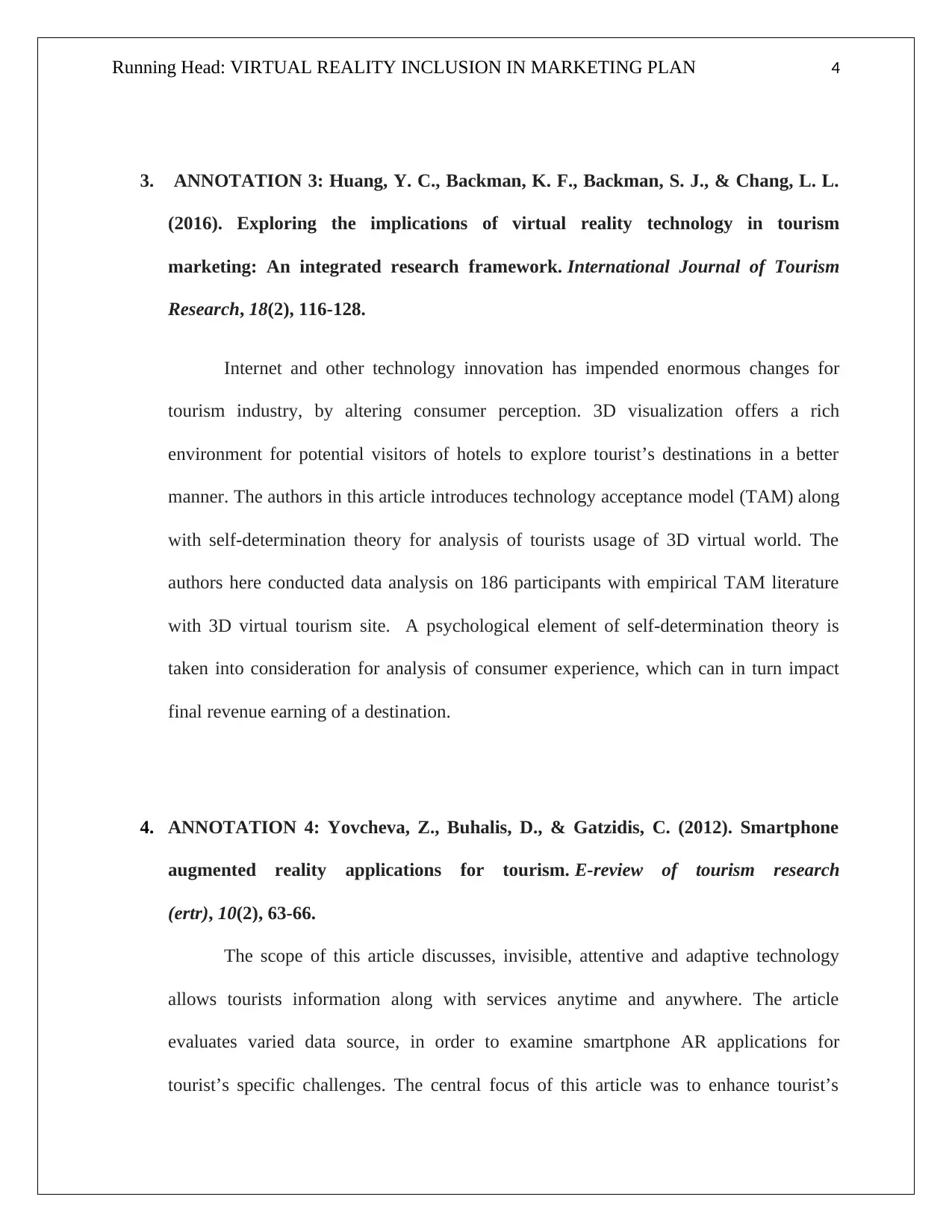
Running Head: VIRTUAL REALITY INCLUSION IN MARKETING PLAN 4
3. ANNOTATION 3: Huang, Y. C., Backman, K. F., Backman, S. J., & Chang, L. L.
(2016). Exploring the implications of virtual reality technology in tourism
marketing: An integrated research framework. International Journal of Tourism
Research, 18(2), 116-128.
Internet and other technology innovation has impended enormous changes for
tourism industry, by altering consumer perception. 3D visualization offers a rich
environment for potential visitors of hotels to explore tourist’s destinations in a better
manner. The authors in this article introduces technology acceptance model (TAM) along
with self-determination theory for analysis of tourists usage of 3D virtual world. The
authors here conducted data analysis on 186 participants with empirical TAM literature
with 3D virtual tourism site. A psychological element of self-determination theory is
taken into consideration for analysis of consumer experience, which can in turn impact
final revenue earning of a destination.
4. ANNOTATION 4: Yovcheva, Z., Buhalis, D., & Gatzidis, C. (2012). Smartphone
augmented reality applications for tourism. E-review of tourism research
(ertr), 10(2), 63-66.
The scope of this article discusses, invisible, attentive and adaptive technology
allows tourists information along with services anytime and anywhere. The article
evaluates varied data source, in order to examine smartphone AR applications for
tourist’s specific challenges. The central focus of this article was to enhance tourist’s
3. ANNOTATION 3: Huang, Y. C., Backman, K. F., Backman, S. J., & Chang, L. L.
(2016). Exploring the implications of virtual reality technology in tourism
marketing: An integrated research framework. International Journal of Tourism
Research, 18(2), 116-128.
Internet and other technology innovation has impended enormous changes for
tourism industry, by altering consumer perception. 3D visualization offers a rich
environment for potential visitors of hotels to explore tourist’s destinations in a better
manner. The authors in this article introduces technology acceptance model (TAM) along
with self-determination theory for analysis of tourists usage of 3D virtual world. The
authors here conducted data analysis on 186 participants with empirical TAM literature
with 3D virtual tourism site. A psychological element of self-determination theory is
taken into consideration for analysis of consumer experience, which can in turn impact
final revenue earning of a destination.
4. ANNOTATION 4: Yovcheva, Z., Buhalis, D., & Gatzidis, C. (2012). Smartphone
augmented reality applications for tourism. E-review of tourism research
(ertr), 10(2), 63-66.
The scope of this article discusses, invisible, attentive and adaptive technology
allows tourists information along with services anytime and anywhere. The article
evaluates varied data source, in order to examine smartphone AR applications for
tourist’s specific challenges. The central focus of this article was to enhance tourist’s
Paraphrase This Document
Need a fresh take? Get an instant paraphrase of this document with our AI Paraphraser
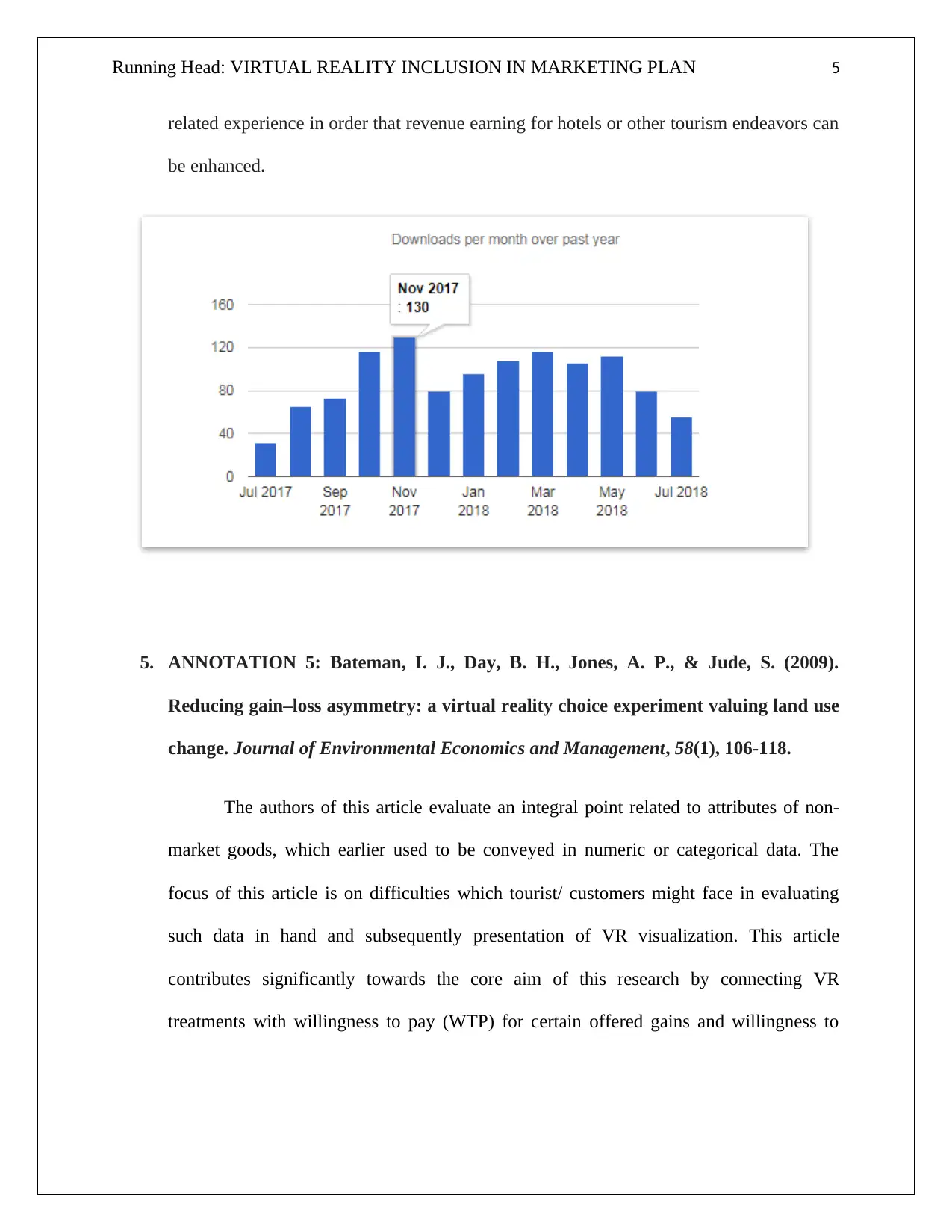
Running Head: VIRTUAL REALITY INCLUSION IN MARKETING PLAN 5
related experience in order that revenue earning for hotels or other tourism endeavors can
be enhanced.
5. ANNOTATION 5: Bateman, I. J., Day, B. H., Jones, A. P., & Jude, S. (2009).
Reducing gain–loss asymmetry: a virtual reality choice experiment valuing land use
change. Journal of Environmental Economics and Management, 58(1), 106-118.
The authors of this article evaluate an integral point related to attributes of non-
market goods, which earlier used to be conveyed in numeric or categorical data. The
focus of this article is on difficulties which tourist/ customers might face in evaluating
such data in hand and subsequently presentation of VR visualization. This article
contributes significantly towards the core aim of this research by connecting VR
treatments with willingness to pay (WTP) for certain offered gains and willingness to
related experience in order that revenue earning for hotels or other tourism endeavors can
be enhanced.
5. ANNOTATION 5: Bateman, I. J., Day, B. H., Jones, A. P., & Jude, S. (2009).
Reducing gain–loss asymmetry: a virtual reality choice experiment valuing land use
change. Journal of Environmental Economics and Management, 58(1), 106-118.
The authors of this article evaluate an integral point related to attributes of non-
market goods, which earlier used to be conveyed in numeric or categorical data. The
focus of this article is on difficulties which tourist/ customers might face in evaluating
such data in hand and subsequently presentation of VR visualization. This article
contributes significantly towards the core aim of this research by connecting VR
treatments with willingness to pay (WTP) for certain offered gains and willingness to
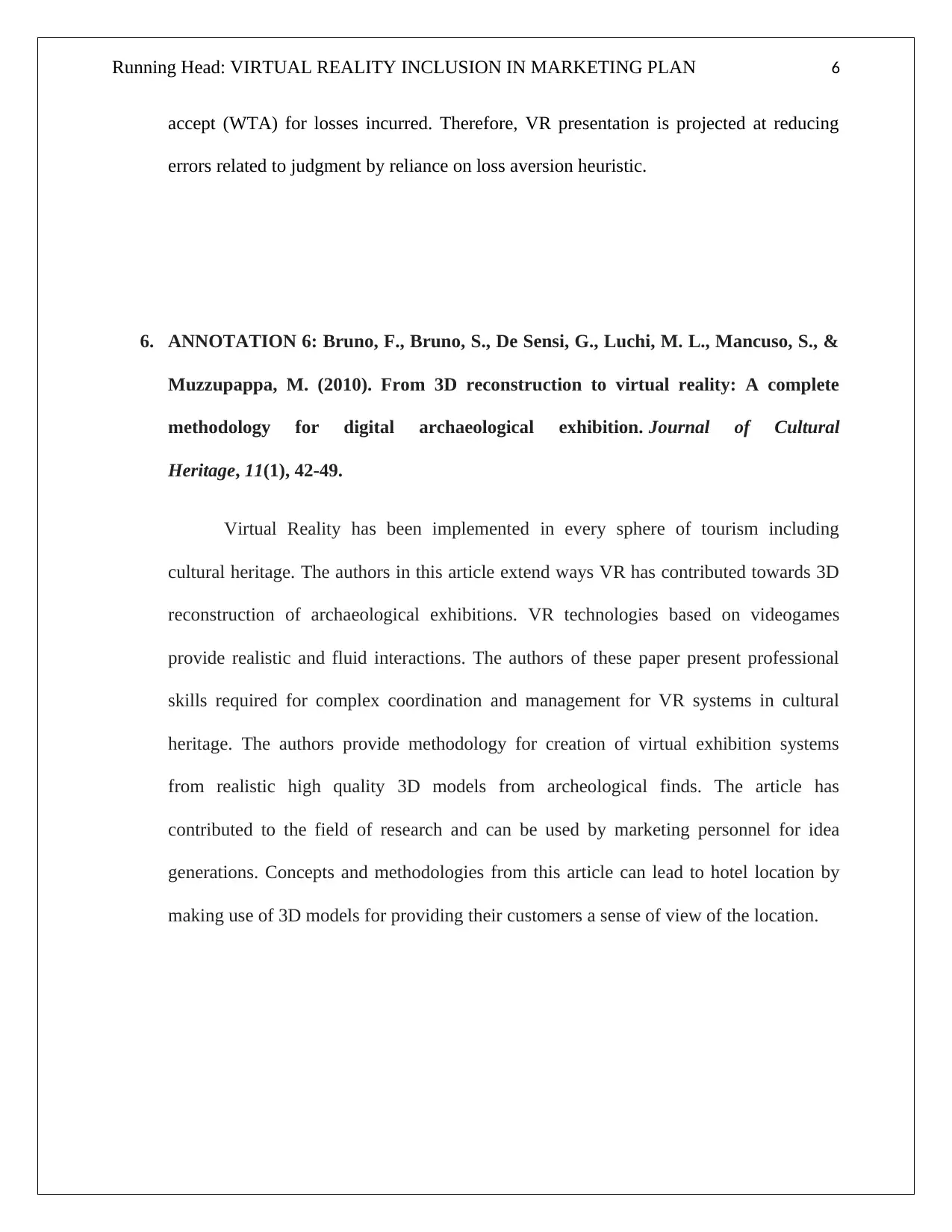
Running Head: VIRTUAL REALITY INCLUSION IN MARKETING PLAN 6
accept (WTA) for losses incurred. Therefore, VR presentation is projected at reducing
errors related to judgment by reliance on loss aversion heuristic.
6. ANNOTATION 6: Bruno, F., Bruno, S., De Sensi, G., Luchi, M. L., Mancuso, S., &
Muzzupappa, M. (2010). From 3D reconstruction to virtual reality: A complete
methodology for digital archaeological exhibition. Journal of Cultural
Heritage, 11(1), 42-49.
Virtual Reality has been implemented in every sphere of tourism including
cultural heritage. The authors in this article extend ways VR has contributed towards 3D
reconstruction of archaeological exhibitions. VR technologies based on videogames
provide realistic and fluid interactions. The authors of these paper present professional
skills required for complex coordination and management for VR systems in cultural
heritage. The authors provide methodology for creation of virtual exhibition systems
from realistic high quality 3D models from archeological finds. The article has
contributed to the field of research and can be used by marketing personnel for idea
generations. Concepts and methodologies from this article can lead to hotel location by
making use of 3D models for providing their customers a sense of view of the location.
accept (WTA) for losses incurred. Therefore, VR presentation is projected at reducing
errors related to judgment by reliance on loss aversion heuristic.
6. ANNOTATION 6: Bruno, F., Bruno, S., De Sensi, G., Luchi, M. L., Mancuso, S., &
Muzzupappa, M. (2010). From 3D reconstruction to virtual reality: A complete
methodology for digital archaeological exhibition. Journal of Cultural
Heritage, 11(1), 42-49.
Virtual Reality has been implemented in every sphere of tourism including
cultural heritage. The authors in this article extend ways VR has contributed towards 3D
reconstruction of archaeological exhibitions. VR technologies based on videogames
provide realistic and fluid interactions. The authors of these paper present professional
skills required for complex coordination and management for VR systems in cultural
heritage. The authors provide methodology for creation of virtual exhibition systems
from realistic high quality 3D models from archeological finds. The article has
contributed to the field of research and can be used by marketing personnel for idea
generations. Concepts and methodologies from this article can lead to hotel location by
making use of 3D models for providing their customers a sense of view of the location.
⊘ This is a preview!⊘
Do you want full access?
Subscribe today to unlock all pages.

Trusted by 1+ million students worldwide
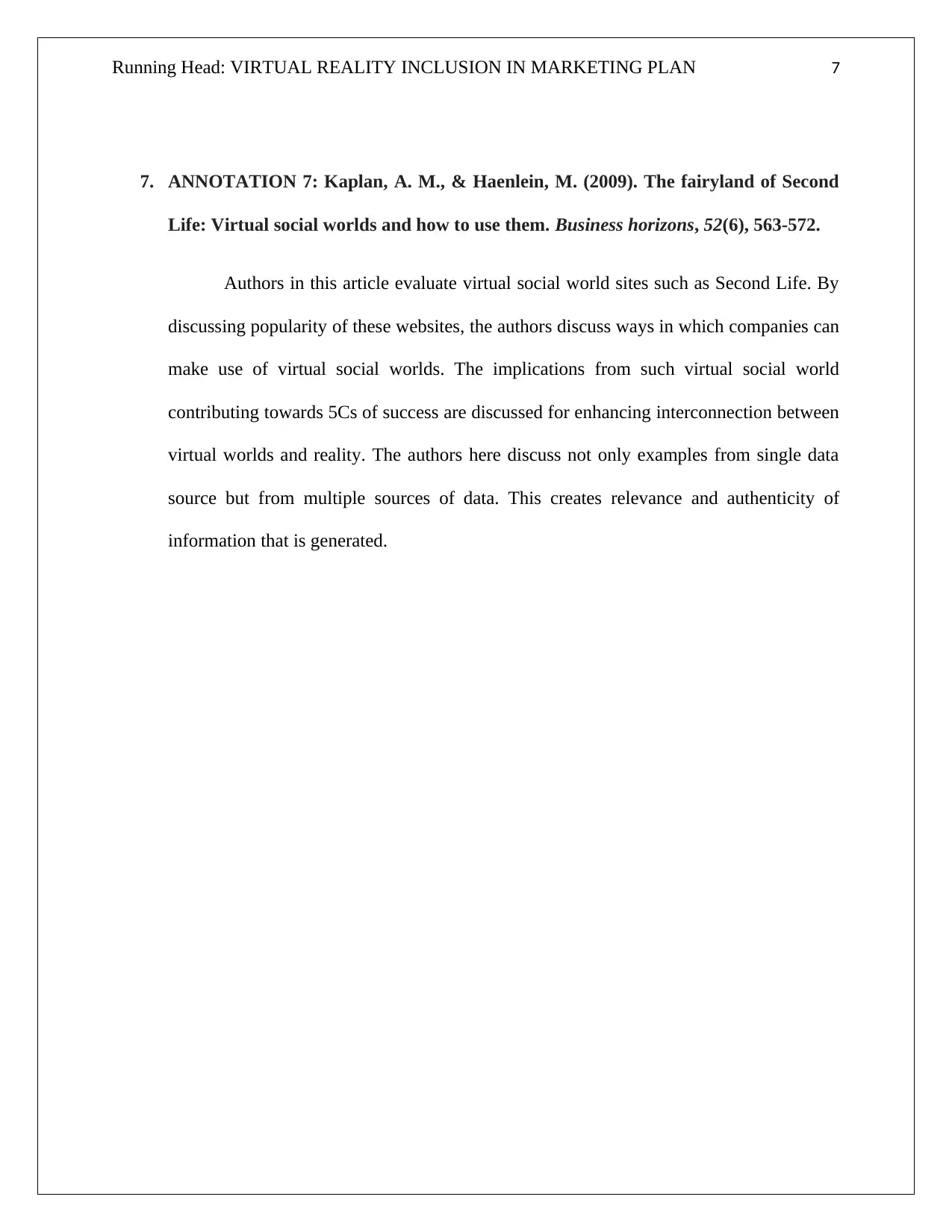
Running Head: VIRTUAL REALITY INCLUSION IN MARKETING PLAN 7
7. ANNOTATION 7: Kaplan, A. M., & Haenlein, M. (2009). The fairyland of Second
Life: Virtual social worlds and how to use them. Business horizons, 52(6), 563-572.
Authors in this article evaluate virtual social world sites such as Second Life. By
discussing popularity of these websites, the authors discuss ways in which companies can
make use of virtual social worlds. The implications from such virtual social world
contributing towards 5Cs of success are discussed for enhancing interconnection between
virtual worlds and reality. The authors here discuss not only examples from single data
source but from multiple sources of data. This creates relevance and authenticity of
information that is generated.
7. ANNOTATION 7: Kaplan, A. M., & Haenlein, M. (2009). The fairyland of Second
Life: Virtual social worlds and how to use them. Business horizons, 52(6), 563-572.
Authors in this article evaluate virtual social world sites such as Second Life. By
discussing popularity of these websites, the authors discuss ways in which companies can
make use of virtual social worlds. The implications from such virtual social world
contributing towards 5Cs of success are discussed for enhancing interconnection between
virtual worlds and reality. The authors here discuss not only examples from single data
source but from multiple sources of data. This creates relevance and authenticity of
information that is generated.
Paraphrase This Document
Need a fresh take? Get an instant paraphrase of this document with our AI Paraphraser
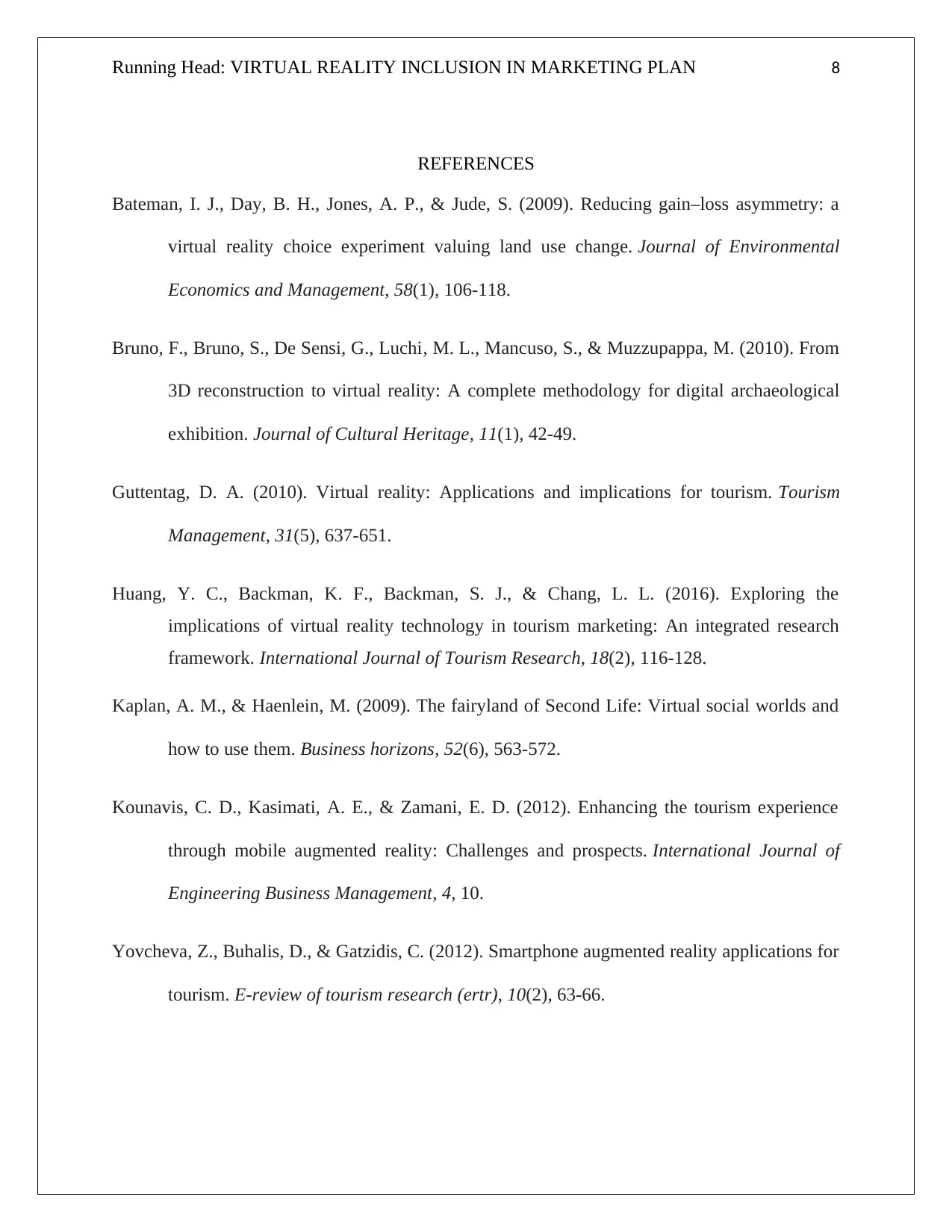
Running Head: VIRTUAL REALITY INCLUSION IN MARKETING PLAN 8
REFERENCES
Bateman, I. J., Day, B. H., Jones, A. P., & Jude, S. (2009). Reducing gain–loss asymmetry: a
virtual reality choice experiment valuing land use change. Journal of Environmental
Economics and Management, 58(1), 106-118.
Bruno, F., Bruno, S., De Sensi, G., Luchi, M. L., Mancuso, S., & Muzzupappa, M. (2010). From
3D reconstruction to virtual reality: A complete methodology for digital archaeological
exhibition. Journal of Cultural Heritage, 11(1), 42-49.
Guttentag, D. A. (2010). Virtual reality: Applications and implications for tourism. Tourism
Management, 31(5), 637-651.
Huang, Y. C., Backman, K. F., Backman, S. J., & Chang, L. L. (2016). Exploring the
implications of virtual reality technology in tourism marketing: An integrated research
framework. International Journal of Tourism Research, 18(2), 116-128.
Kaplan, A. M., & Haenlein, M. (2009). The fairyland of Second Life: Virtual social worlds and
how to use them. Business horizons, 52(6), 563-572.
Kounavis, C. D., Kasimati, A. E., & Zamani, E. D. (2012). Enhancing the tourism experience
through mobile augmented reality: Challenges and prospects. International Journal of
Engineering Business Management, 4, 10.
Yovcheva, Z., Buhalis, D., & Gatzidis, C. (2012). Smartphone augmented reality applications for
tourism. E-review of tourism research (ertr), 10(2), 63-66.
REFERENCES
Bateman, I. J., Day, B. H., Jones, A. P., & Jude, S. (2009). Reducing gain–loss asymmetry: a
virtual reality choice experiment valuing land use change. Journal of Environmental
Economics and Management, 58(1), 106-118.
Bruno, F., Bruno, S., De Sensi, G., Luchi, M. L., Mancuso, S., & Muzzupappa, M. (2010). From
3D reconstruction to virtual reality: A complete methodology for digital archaeological
exhibition. Journal of Cultural Heritage, 11(1), 42-49.
Guttentag, D. A. (2010). Virtual reality: Applications and implications for tourism. Tourism
Management, 31(5), 637-651.
Huang, Y. C., Backman, K. F., Backman, S. J., & Chang, L. L. (2016). Exploring the
implications of virtual reality technology in tourism marketing: An integrated research
framework. International Journal of Tourism Research, 18(2), 116-128.
Kaplan, A. M., & Haenlein, M. (2009). The fairyland of Second Life: Virtual social worlds and
how to use them. Business horizons, 52(6), 563-572.
Kounavis, C. D., Kasimati, A. E., & Zamani, E. D. (2012). Enhancing the tourism experience
through mobile augmented reality: Challenges and prospects. International Journal of
Engineering Business Management, 4, 10.
Yovcheva, Z., Buhalis, D., & Gatzidis, C. (2012). Smartphone augmented reality applications for
tourism. E-review of tourism research (ertr), 10(2), 63-66.
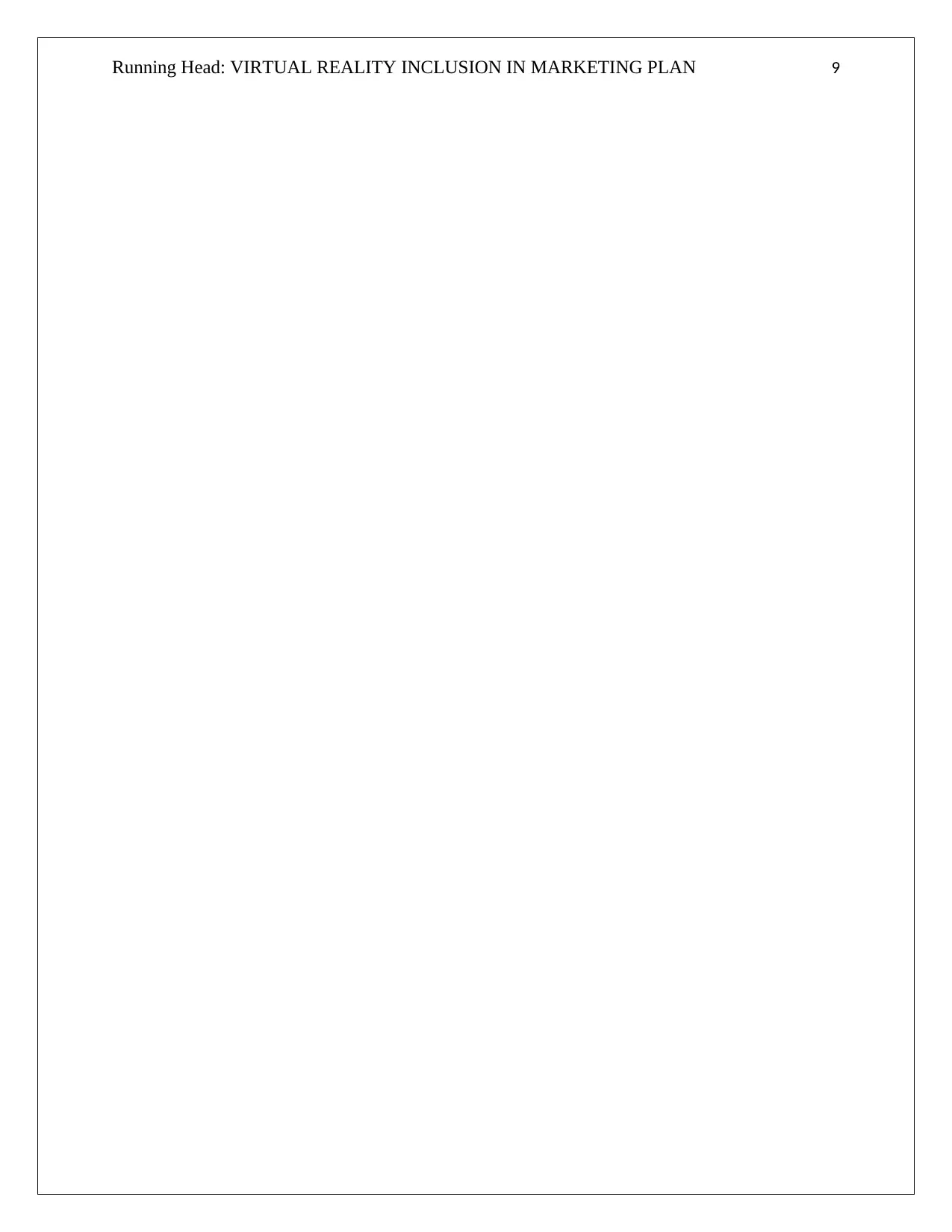
Running Head: VIRTUAL REALITY INCLUSION IN MARKETING PLAN 9
⊘ This is a preview!⊘
Do you want full access?
Subscribe today to unlock all pages.

Trusted by 1+ million students worldwide
1 out of 9
Related Documents
Your All-in-One AI-Powered Toolkit for Academic Success.
+13062052269
info@desklib.com
Available 24*7 on WhatsApp / Email
![[object Object]](/_next/static/media/star-bottom.7253800d.svg)
Unlock your academic potential
Copyright © 2020–2025 A2Z Services. All Rights Reserved. Developed and managed by ZUCOL.





